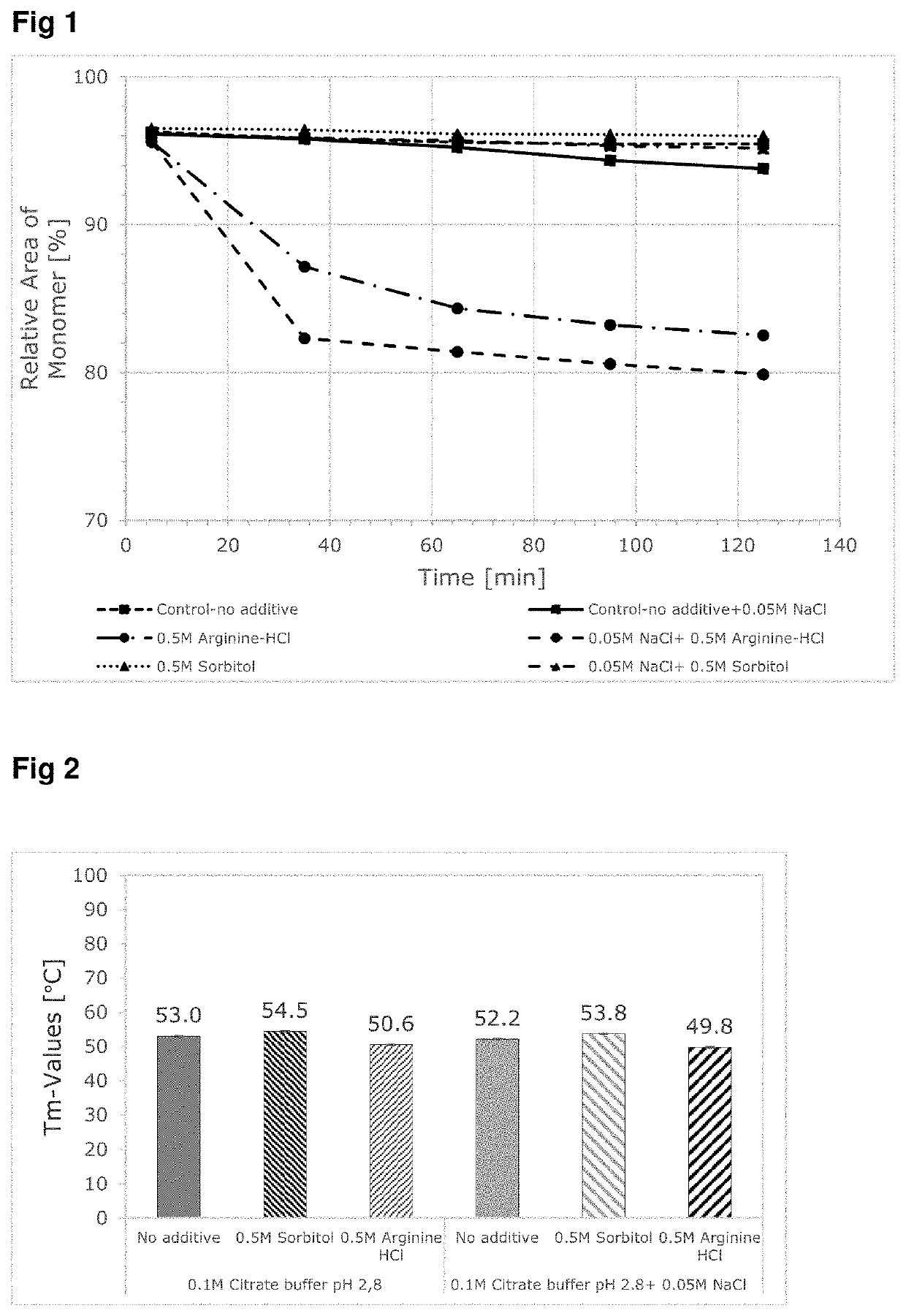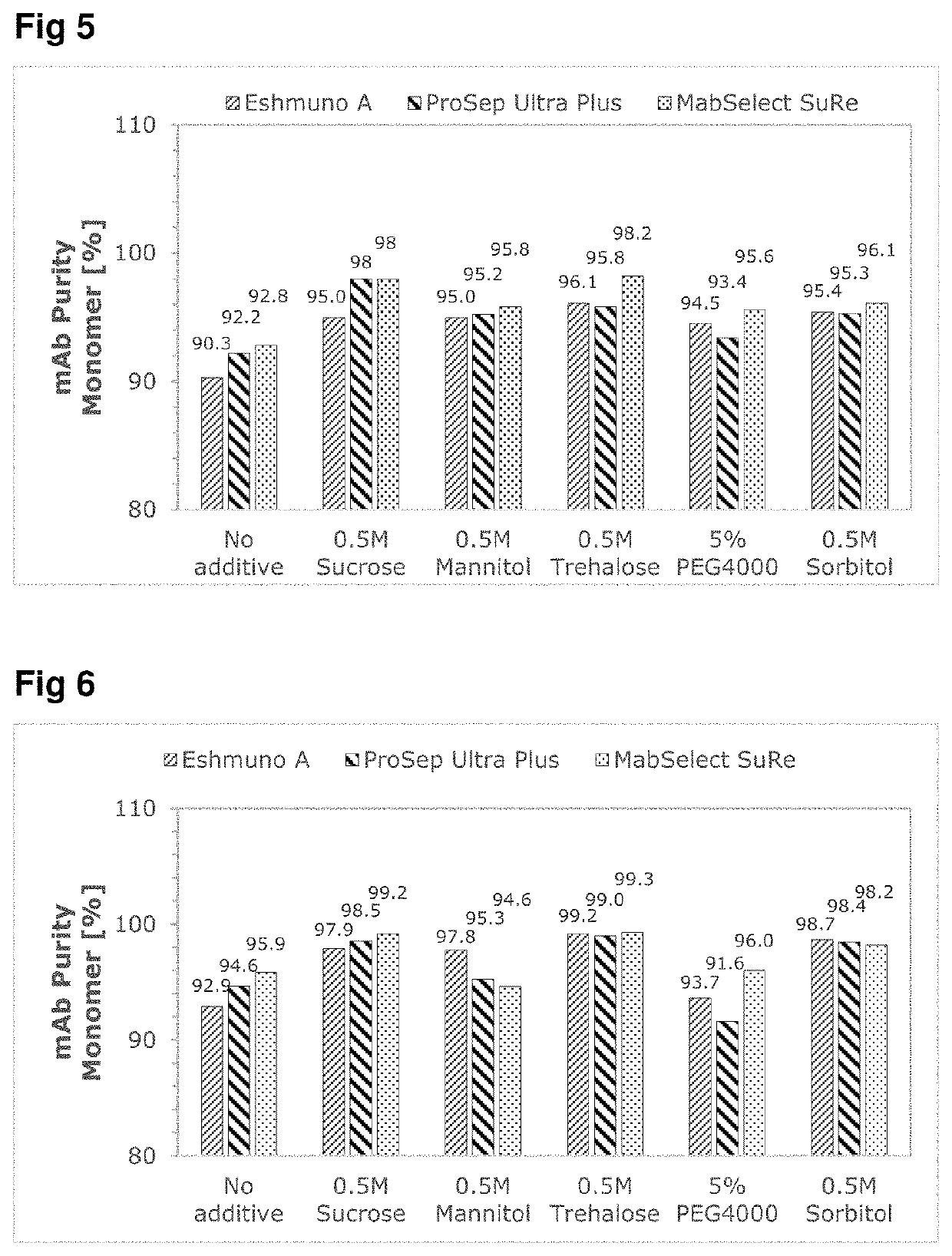Purification of proteins and viral inactivation
- Summary
- Abstract
- Description
- Claims
- Application Information
AI Technical Summary
Benefits of technology
Problems solved by technology
Method used
Image
Examples
example 1
ng Effect of Selected Excipients on Low pH Induced Aggregation Test (In-Vitro)
[0067]The effect of the use of neutral excipients on mAbs during low pH stress conditions simulating the protein A chromatography and virus inactivation steps during downstream processing of monoclonal antibodies have been evaluated in-vitro. The in-vitro screening tests have been performed with an incubation experiment of two model proteins (mAbA and mAbB) at low pH values with or without the addition of NaCl. The effects of these experiments on the conformational stability, fragmentation and aggregation behavior of the samples were analyzed using kinetic-SEC and nanoDSF and compared against control conditions without exipient.
[0068]Furthermore, an ionic excipient (arginine HCl) was also used as a negative control to show the destabilizing effect of unsuitable excipients for incubation at low pH condition.
example 1.1
of 0.25M Citrate Buffer pH 3.0
[0069]Solution A: 0.25M Citric Acid Monohydrate (C6H8O7.H2O FW=210.14)
[0070]52.5 g citric acid monohydrate (M=210.14 g / mol) was weighed into an appropriate flask. 500 ml milli-Q-water was added and the solution was stirred until the substance was completely dissolved.
Solution B: 0.25M Trisodium Citrate, Dihydrate (C6H5O7Na3.2H2O FW=294.12)
[0071]18.4 g trisodium citrate, dihydrate (M=294.12 g / mol) was weighed into an appropriate flask. 500 ml milli-Q-water was added and the solution was stirred until the substance was completely dissolved.
[0072]Approximately 415 ml of solution A and approximately 85 ml of Solution B were mixed too obtain approximately 500 ml 0.25M citrate buffer pH 3.0. The pH was adjusted to 3.0±0.05 using 1M HCl solution or 1M NaOH if necessary.
[0073]The buffer was filtered using a 0.45 μm HAWP mixed cellulose ester filter (Merck, Darmstadt, Germany) and degassed for 20 min in an ultrasonic bath before use.
example 1.2
ple Preparation
[0074]The tested proteins are mAbA and mAbB.
[0075]mAbA is a monoclonal antibody (app. 152 kDa) with a pl˜7.01-8.58. It was post TFF purified mAb and formulated with 10 mM citrate buffer pH 5.5, 0.1M NaCl, 0.1M Glycine. The solution has a concentration of 16 mg / mL.
[0076]mAbB is a monoclonal antibody (app. 145 kDa) with a pl˜7.6-8.3. It was post TFF purified mAb and formulated with 50 mM sodium acetate pH 5.0. The solution has a concentration of 80 mg / mL.
TABLE 1Sample preparation for in vitro excipient screeningFinal Screening Conditions0.1M citrate buffer pH 2.8no5%0.5M0.5M0.5M0.5M0.5MexcipientPEG4000sucrosetrehalosesorbitolmannitolarginine HClStockorororororororSolution(+0.05M NaCl)(+0.05M NaCl)(+0.05M NaCl)(+0.05M NaCl)(+0.05M NaCl)(+0.05M NaCl)(+0.05M NaCl)0.25M citrate20000μl20000μl20000μl20000μl20000μl20000μl20000μlbuffer pH 3.012.5%0μl20000μl20000μl20000μl20000μl20000μl20000μlPEG4000 or1.25M polyolsandDisaccharidesor arginine-HCl5M NaCl0μl0μl0μl0μl0μl0μl0μl(or 50...
PUM
 Login to View More
Login to View More Abstract
Description
Claims
Application Information
 Login to View More
Login to View More - R&D
- Intellectual Property
- Life Sciences
- Materials
- Tech Scout
- Unparalleled Data Quality
- Higher Quality Content
- 60% Fewer Hallucinations
Browse by: Latest US Patents, China's latest patents, Technical Efficacy Thesaurus, Application Domain, Technology Topic, Popular Technical Reports.
© 2025 PatSnap. All rights reserved.Legal|Privacy policy|Modern Slavery Act Transparency Statement|Sitemap|About US| Contact US: help@patsnap.com



